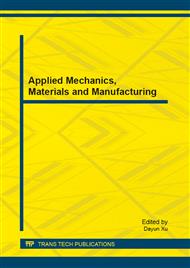[1]
G. Hulkó, et al.: Distributed Parameter Systems Blockset for MATLAB & Simulink – Third-Party Product of The MathWorks, Publishing house of STU, Bratislava, (2003-2013) http: /www. mathworks. com/products/connections.
Google Scholar
[2]
G. Hulkó, et al.: Control of Energy Systems as Distributed Parameter Systems with Software Support by Virtual Software Environments, Proceedings of the 51st IEEE Conference on Decision and Control, pp.2382-2387. Maui, Hawaii (2012).
DOI: 10.1109/cdc.2012.6426762
Google Scholar
[3]
K. Ondrejkovič, et al.: Control of Continuous Casting Processes as Distributed Parameter Systems, Proceedings of METEC InSteelCon 2011, 7-th European Continuous Casting Conference. Düsseldorf (2011).
Google Scholar
[4]
V. Rudnev: Simulation of Induction Heating Prior to Hot Working and Coating, In: ASM Handbook Volume 22B - Metal Process Simulation, pp.475-500. ASM International (2010).
DOI: 10.31399/asm.hb.v22b.a0005516
Google Scholar
[5]
G. Hulkó, et al.: Engineering Methods and Software Support for Modeling and Design of Discrete-time Control of Distributed Parameter Systems, In: European Journal of Control, Volume 15, (no. 3–4), p.55–73, (2009).
DOI: 10.3166/ejc.15.407-417
Google Scholar
[6]
E. Rapoport, Y. Pleshivtseva: Optimal Control of Induction Heating Processes, Taylor&Francis Group. New York, (2007).
Google Scholar
[7]
M. Behúlová, B. Mašek, et al.: Static and Dynamic Induction Heating - Experiment and Numerical Simulation, In: MP Materialprüfung, Volume 48, pp.217-224, (2006).
DOI: 10.3139/120.100730
Google Scholar
[8]
V. Rudnev, D. Loveless, et al.: Handbook of Induction Heating, Marcel Dekker, (2003).
Google Scholar
[9]
G. Hulkó, et al.: Modeling, Control and Design of Distributed Parameter Systems with Demonstrations in MATLAB, Publishing house of STU, Bratislava, http: /www. mathworks. com/support/books, (1998).
Google Scholar
[10]
J. Kapusta, J. Camber, G. Hulkó: Modeling of Induction Heating of Steel Billets for DPS Control Design Purposes, Proceedings of COMSOL Conference, Bangalore, India (2012).
Google Scholar
[11]
J. Kapusta, J. Camber, G. Hulkó: Modeling and Control of Steel Billet Induction Heater. Submitted to 1st IFAC Workshop on Control of Systems Modeled by Partial Differential Equations, Paris, France (2013).
Google Scholar
[12]
COMSOL Multiphysics User's Guide, COMSOL Inc., (1998-2011).
Google Scholar


